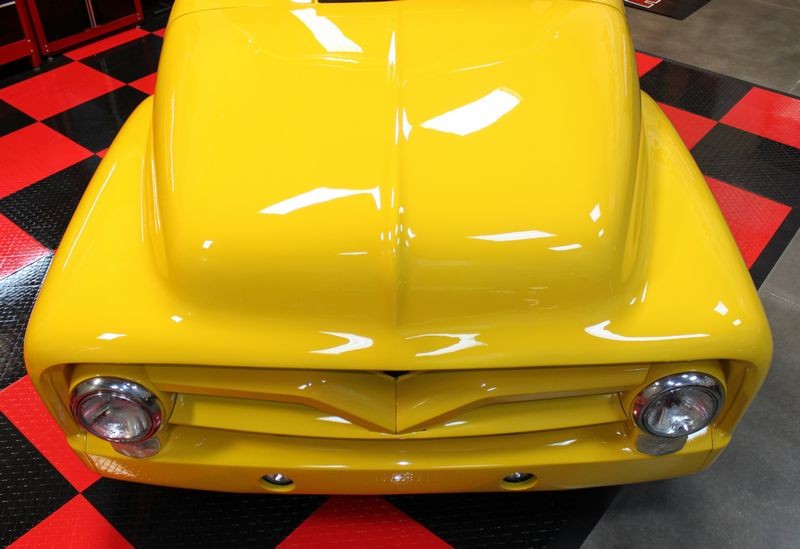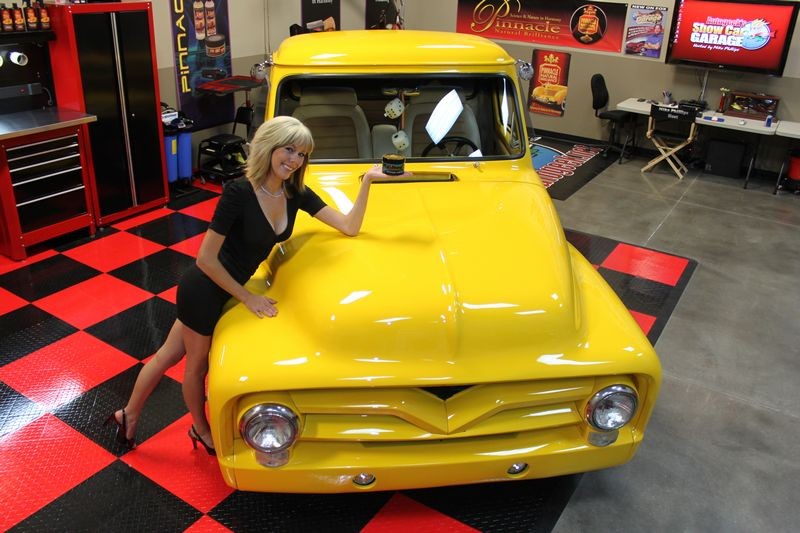 Dislikes: 0
-
How To Detail Your Brand New Car by Mike Phillips
How To Detail Your Brand New Car by Mike Phillips
Below is the order of steps to do to your brand new car, truck or sports utility vehicle. Note that even a brand new car may need some of the below procedures because car paint becomes contaminated while it's being shipped and while it's being stored.
Also, dealerships are notorious for putting their new cars through their own detail shop to get them ready to sell only to have their in-house detailers instill swirls and scratches at the same time they're supposed to be making the car look beautiful.
It's sad to say, but that's how the new and used car dealerships here in the United States work.
So after getting your brand new car, or your new-to-you used car home, here's what you do.
- Wash and dry.
- Inspect the paint with your sense of touch and visually in bright, overhead sunlight.
- Iron X paint and wheels - Then re-wash to remove the Iron X residues off the paint and wheels.
- Clay - If needed. Your inspection will tell you.
- Polish - If needed. Your inspection will tell you.
- Apply either a Car Wax or a Paint Sealant
Note: You really only need to use one type of protection product. Some people use two types but you don't have to. Instead you could apply two coats of the same product. Protection products include,
- Car Waxes
- Synthetic Paint Sealants
- Paint Coatings
How to inspect your car's paint after you have washed and dried it.
Watch the below short videos. In them, I show you how to inspect your car's paint. It is by inspecting your car's paint that you determine what needs to be done.
This is one of my better write-ups with over 100 high resolution pictures showing before, process and after shots. Here's the link to the entire thread.
1954 Ford F-100 - Extreme Makeover - Process and products used
Here's what you want to do to any car that you're going to detail
First, wash and dry the car so you remove any loose dirt. This keeps you from rubbing the dirt into the paint when you feel it with your hand or a baggie for above surface bonded contaminants.
It also removes the dirt to get it out of the way so your eyes can SEE if there are any swirls in the paint.
So wash and dry first, then inspect with your sense of touch and visually with your eyes.
How to feel the paint with your hand to check and see if you need to clay the paint
How to inspect the paint using the sun to check for swirls, holograms and scratches
Your results and what to do?
Paints is in good shape
If the paint feels smooth as glass and if you don't see any swirls or scratches, or if swirls and scratches don't bother you then you can keep it simple and,
A: Apply a wax or paint sealant - Skip all other steps after washing and drying and inspecting.
B: Use a pre-wax cleaner and then apply a wax or paint sealant. A pre-wax cleaner, also called a paint cleaner simply ensures the paint surface is squeaky clean and clear and perfectly prepared to accept a wax or paint sealant. If you opt to use a paint coating you'll want to follow the manufactures directions for prepping the paint before applying the coating as directions vary.
Paints is in bad shape
If you discover the paint has above surface bonded contaminants then you need to clay the paint. You have two options,
Option 1: Wash and dry the car and then clay paint.
This is the normal way most people started their detailing project till products like Iron-X were introduced. That is after washing, drying and inspecting, if they felt contaminants on the paint they would move onto the claying step.
Option 2: Wash and dry the car and then use an iron and contamination remover and then re-wash the car to remove the Iron X residue and dissolved iron particles. Dry the car and then clay the paint.
The benefit this approach offers is,
IF there are any iron particles in your car's paint you will dissolve and remove them chemically with the Iron-X instead of abrading and pulling them out with clay and then potentially instilling swirls and scratches into the paint because now you have iron particles embedded into the clay that you're rubbing all over the paint.
Iron X = Insurance Policy
In my opinion, doing an Iron-X treatment to paint that you've never worked on before is a good idea, it's like an insurance policy. You buy insurance to protect ourself but you hope you never need it.
You use Iron-X JUST IN CASE there's any iron particles in the paint but you actually hope that there's not.
It's better to use Iron-X and NOT see the spray turn red than it is to see the spray turn read. Think about it, if it turns red that means there was iron particles in the paint, that's a bad thing. If it doesn't, it's whew... I got lucky.
Then after choosing and following the steps in one of the above options you move on to the next step, which is usually doing some type of correction work to the paint using a combination of compounds and polishes, or keep it simple and use what are called pre-wax cleaners or paint cleaners.
Both of these steps,
Correcting with compounds and/or polishes
OR (You don't do both, pick one or the other)
Using a Pre-Wax cleaner
Are done after the washing, claying steps and before the sealing step where you will apply your choice of a,
- Car Wax
- Synthetic Paint Sealant
- Ceramic Paint Coating
Each of the three categories above are different types of products that do the same general thing and that is leave a layer of protection on the paint to protect it and make the paint look good.
You only need to use one product from one of the three categories. You don't have to use products from more than one category although a lot of "Serious Car Enthusiasts" will as an option apply a synthetic paint sealant first for long lasting, durable protection and top this sealant with a coat of wax for aesthetics reasons, that is to make the paint look beautiful.
See this article,
Topping - Definition - How to Top also called Topping
Maintaining your car
After all of the above is done, you can then maintain your car's finish using a combination of spray detailers and spray waxes or spray sealants.
A spray detailer is for removing,
- Light dust
- Fingerprints
- Smudges
- Clay Lube (when claying)
A spray wax or a spray sealant is typically a faster, shortcut way of restoring that just waxed look without having to actually get out a traditional liquid or paste type product. Instead you mist on the spray wax or spray sealant, spread it around and wipe it off in the same way you would use a spray detailers.
People get confused as to what the difference is between a spray detailer and a spray wax so here's the difference,
A spray detailer is for cleaning your car, getting dust of it without scratching the paint. A spray on wax or spray-on sealant is for adding more protection to paint that is ALREADY CLEAN, for example after you wash the car or AFTER YOU USE A SPRAY DETAILER.
Simple really, but for some reason a lot of people get confused over spray detailers and spray waxes.
I certainly don't want to scare anyone or make washing and waxing your car any more complicated than it has to be, I'm just trying to lay out ALL the various factors to consider if the car in question is important to you as well as your time and money/investment.
Here's how the 1954 Ford came out after doing all the necessary steps and then applying a coating of Pinnacle Signature Series II

-
Post Thanks / Like - 1 Thanks, 0 Likes, 0 Dislikes
Similar Threads
-
By Mike Phillips in forum Ask your detailing questions!
Replies: 27
Last Post: 04-01-2021, 01:14 PM
-
By Mike Phillips in forum Show N' Shine
Replies: 20
Last Post: 01-19-2021, 11:02 PM
-
By Mike Phillips in forum Ask your detailing questions!
Replies: 10
Last Post: 01-29-2015, 10:37 AM
-
By Nick McKees37 in forum Autogeek's DetailFest Info
Replies: 9
Last Post: 03-06-2012, 05:52 PM
 Members who have read this thread: 1
Members who have read this thread: 1
 Posting Permissions
Posting Permissions
- You may not post new threads
- You may not post replies
- You may not post attachments
- You may not edit your posts
-
Forum Rules
|
| S |
M |
T |
W |
T |
F |
S |
| 26 | 27 | 28 | 29 | 30 | 31 |
1
|
|
2
|
3
|
4
|
5
|
6
|
7
|
8
|
|
9
|
10
|
11
|
12
|
13
|
14
|
15
|
|
16
|
17
|
18
|
19
|
20
|
21
|
22
|
|
23
|
24
|
25
|
26
|
27
|
28
|
29
|
|
30
| 1 | 2 | 3 | 4 | 5 | 6 |
|













 Thanks:
Thanks:  Likes:
Likes:  Dislikes:
Dislikes: 





 Reply With Quote
Reply With Quote
Bookmarks